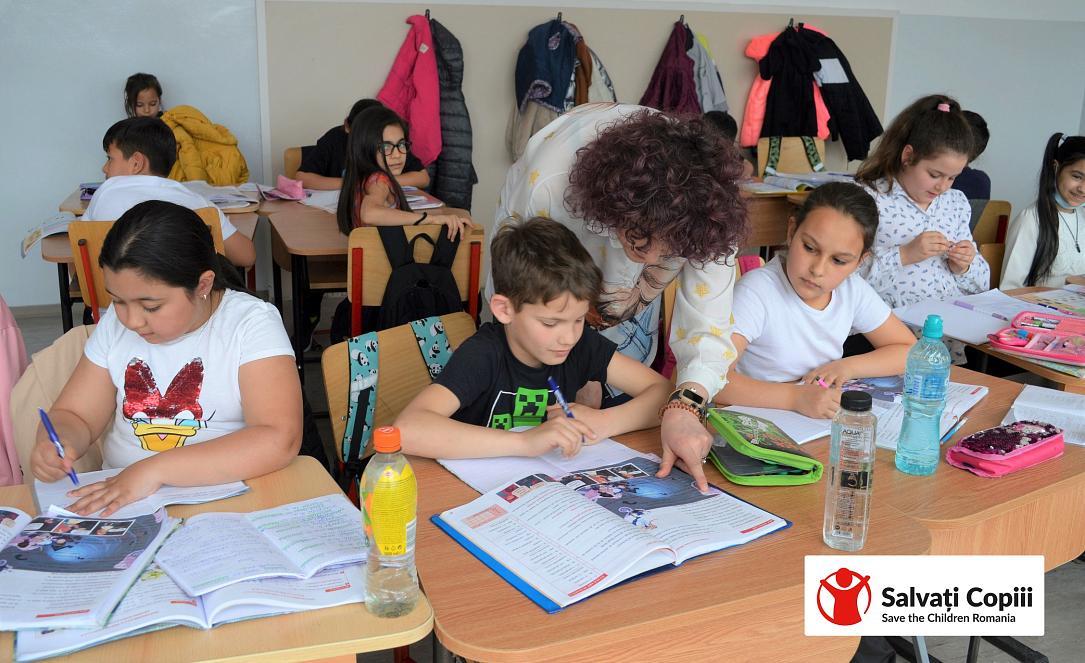Save the Children Romania: PISA tests reveal 3-year schooling difference between children from different backgrounds

The recently released PISA 2022 tests reveal the gap between the results of Romanian children vulnerable to poverty and those from advantaged social backgrounds has increased. The gap is equivalent to a difference of 3 years of schooling between children.
The educational gap has increased by almost one year of school between 2018 and 2022, according to the PISA results, the Save the Children Romania press release highlights. The gap's growth was driven both by a decrease in the performance of poor students (-11 points) and an improvement in the performance of advantaged students (+13 points). The difference is especially evident in performance in mathematics.
There is also a regional gap in the Romanian education system. Before the PISA evaluations, Save the Children Romania drew attention to the fact that the results of Romanian students in the National Evaluation exam reflect the disparities and socio-economic inequalities between the regions of Romania. The Northeast and South-Muntenia regions, consistently identified in almost all comparative analyses of the European Union as the poorest areas in Europe (38.2% - 2022 and 37.1%, respectively), have the most grades below 5 (27.8% and 29.5%) in the National Evaluation.
"Beyond the highlighted issues in the foreground, which indicate a stagnation in the ability of Romanian students to understand a text and apply knowledge in mathematics and other sciences, Romania is among the countries where the difference generated by socioeconomic status has deepened significantly in the last 10 years, an exception to the general trend at the OECD level (where this difference has only experienced minor growth). 'Poverty kills education' is not just a slogan but the dramatic reality of children from disadvantaged socio-economic backgrounds," warned Gabriela Alexandrescu, executive president of Save the Children Romania.
The organization points to several trends and correlations between material poverty and poor performance in the National Evaluation. Overlaying the maps of poverty and material deprivation with the map of educational performance highlights educational poverty and the need for intervention in these regions. Moreover, 4 out of 10 children (39.56%) graduating from primary schools in rural areas of Romania had grades below 5, while 21.5% of urban students achieved scores higher than 9. Children in cities with a perfect ten were 14 times more numerous than those living in rural areas.
Save the Children's analyses showed that parents in urban areas spend 30-40% more on additional preparation, through tutoring or extended school programs, for their children. Additionally, tutoring represents a significant cost category, around RON 2,500 (EUR 500) annually in 2021, an amount very few parents in rural areas can afford.
Supportive policies such as expanding the After-School and Healthy Meal programs could alleviate some of the material deprivation stopping children from excelling, according to the organization. Setting up more nurseries and kindergartens in rural areas is another measure that could be taken, in addition to strengthening social services.
Romanian children are the most affected European children by the risk of poverty, social exclusion, and severe material deprivation. In 2021, over 1.5 million children in Romania (41.5% of the total number of children) were at risk of poverty or social exclusion, and this intensity increased compared to previous years.
The risk of poverty or social exclusion among children is much higher in rural areas than in urban areas: in 2021, the rate was 16.1% in large cities, 30.7% in small urban and suburban areas, and 50.1% in rural areas.
The lack of access to remedial education after two years of pandemic and pseudo-online education and the organization of additional educational interventions based on local, reduced, or poorly administered resources have exacerbated gaps in knowledge and skills compared to other children in large cities or developed communities, inevitably leading to the social isolation of children and their families. This is the aspect of "educational poverty," an indicator proposed by Save the Children as a strategic reference for the elimination of systematic discrimination against socio-economically disadvantaged communities, especially in rural areas, in the allocation of resources for children, education, protection, and medical assistance.
From the OECD report on the Romanian economy, it is evident that there is a significant concentration of poverty in rural regions, making these areas the most affected in the European Union in terms of unequal access to jobs and infrastructure (education, health, transport). The report also emphasizes that the risk of poverty is particularly high for families with children, individuals with low work intensity, and low educational levels, people with disabilities, and the Roma community, stating that "the poverty rate of childhood is over three times higher in rural areas than in urban areas."
In this context, accentuated inequalities in access to education are highlighted across Romania, with huge disparities between urban and rural areas in terms of educational achievements and learning outcomes. The difference in PISA performance between rural and urban regions is mainly explained by differences in socio-economic status with a significant impact on educational outcomes, suggesting that the difference in educational outcomes between students from high socio-economic status and those from more disadvantaged backgrounds is so great that it is similar to what a student would learn in three years of school.
OECD experts conclude that more resources should be allocated to schools in disadvantaged areas at the preschool and primary education levels, and improving educational performance without increasing expenditures is, in their opinion, challenging. Budget allocations for education are considered modest, representing only 3.6% of GDP in 2019, compared to 4.7% in the EU, and per-pupil expenditures in primary and secondary education are less than one-third of the EU average, affecting the long-term academic performance of children.
(Photo source: Save the Children Romania)













